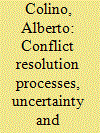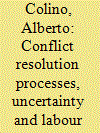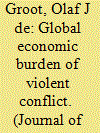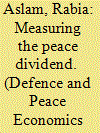|
|
|
Sort Order |
|
|
|
Items / Page
|
|
|
|
|
|
|
| Srl | Item |
| 1 |
ID:
120394


|
|
|
|
|
| Publication |
2013.
|
| Summary/Abstract |
In this article, the economic impact of diminishing levels of uncertainty on investment, as a result of conflict resolution processes, is tested by means of a case study on a European region largely affected by political violence. For this purpose, the response of Basque investment during conflict resolution attempts is used as a natural experiment with which to evaluate the effect of reduced uncertainty on productive investment. Thus, it is found that productive investment in the Basque Country increased considerably when credible peace talks directed towards the end of the conflict were undertaken. Accordingly, when compared with other subsets of comparable Spanish provinces, the truces declared in 1988 and 1998 propelled the growth rate of investment in this region by 21.2 and 25.8 percentage points, respectively. This finding gives an idea on the magnitude of the potential peace dividend to be reaped in the event of an eventual conflict resolution and a complete cessation of political violence in the region.
|
|
|
|
|
|
|
|
|
|
|
|
|
|
|
|
| 2 |
ID:
117592


|
|
|
|
|
| Publication |
2012.
|
| Summary/Abstract |
In this article, the impact of diminishing levels of uncertainty on labour demand, as a consequence of conflict resolution processes, is tested by means of a case study of a European region largely affected by political violence. For this purpose, the response of Basque manufacturing employment during conflict resolution attempts is used as a natural experiment with which to evaluate the effect of reduced uncertainty on labour demand. Accordingly, using the difference-in-differences technique, which overcomes some of the shortcomings of previous studies, the relative performance of Basque labour demand during the last two attempts to bring peace to the region is quantified. The longest ceasefire episode ever declared in the region is shown to have triggered a reactivation in labour demand and, therefore, that Basque manufacturing firms responded positively to the reduction in uncertainty by significantly raising their average number of employees. More precisely, it is found that the average number of workers employed by Basque manufacturing firms increased considerably when credible peace talks directed towards the end of the conflict were undertaken. Thus, when compared with their counterparts in similar Spanish provinces, the truce declared in 1998 boosted employment demand in Basque companies by more than 4%, which reflects the economic dividend of peace to be reaped in the event of an eventual conflict resolution and the establishment of a peaceful environment in the region.
|
|
|
|
|
|
|
|
|
|
|
|
|
|
|
|
| 3 |
ID:
184204


|
|
|
|
|
| Summary/Abstract |
Calculating the consequences of global public bads such as climate change or pandemics helps uncover the scale, distribution and structure of their economic burdens. As violent conflict affects billions of people worldwide, whether directly or indirectly, this article sets out to estimate its global macro-economic repercussions. Using a novel methodology that accounts for multiple dimensions of war, the article finds that, in the absence of violent conflict since 1970, the level of global GDP in 2014 would have been, on average, 12% higher. When disaggregating these results by conflict type, civil conflicts are estimated to have been the costliest by far. Income growth is found to be altered up to four years following the end of a conflict, although the direction of this relationship depends on the intensity and type of conflict. Countries also suffer significantly from fighting in neighbouring countries, thereby showing the importance of mitigating spillovers rapidly. The largest absolute losses associated with violence emanate from Asia, while many high-income economies are found to benefit economically from participating in conflicts on foreign soil. This analysis thus shows that, despite some evidence of a faster post-conflict growth and possible benefits for external participants, violent conflict leads to net global losses that linger long after peace is achieved, reducing the peace dividend. The article concludes by discussing public policy options to strengthen the benefits of peace as a global public good.
|
|
|
|
|
|
|
|
|
|
|
|
|
|
|
|
| 4 |
ID:
076428


|
|
|
|
|
| Publication |
2007.
|
| Summary/Abstract |
The paper attempts to trace the nexus between defense spending and economic growth in developing countries, using data for 59 developing countries from 1972-2000. The purpose is to measure the opportunity costs of defense spending mainly in terms of alternative public programs. The correlation of social sector expenditures with growth rate as well as the extent of correlation between social and defense sector spending is not clear in the majority of developing countries. It follows that even if defense spending is reduced, the prospects for a peace dividend in the aftermath of the Cold War might be inhibited by political interests that oppose increases in social sector expenditures. If so, defense cutbacks might not lead to a welfare windfall as is generally presumed. Accordingly, this paper tests whether a defense spending cutback will enhance funding for other public programs and whether such a reallocation of resources will prove to be beneficial for the long-term growth rate of the economy
|
|
|
|
|
|
|
|
|
|
|
|
|
|
|
|
| 5 |
ID:
086263


|
|
|
|
|
| Publication |
2009.
|
| Summary/Abstract |
This paper examines the peace dividend effect of Turkish convergence to EU membership. By employing a multi-region dynamic CGE model, we examine the prospect for conflict resolution if Turkey becomes an EU member. The model allows us to analyse several scenarios that imply varying amounts of reduction of the military expenditure/GDP ratios. On the one hand, this change will cause a decrease in sectoral demand for military expenditures, while on the other hand, reallocation of the reduced expenditure on (i) education, (ii) tax decrease, and (iii) infrastructure, should have a huge growth impact. Our dynamic CGE simulation experiments emphasize the economic gain for all parties involved.
|
|
|
|
|
|
|
|
|
|
|
|
|
|
|
|
| 6 |
ID:
131990


|
|
|
|
|
| Publication |
2014.
|
| Summary/Abstract |
Northern Ireland's current period of relative peace and political stability has been varyingly attributed to large amounts of international economic development assistance and the funding of grassroots peacebuilding work. Yet the post-accord peace is punctuated by seemingly sporadic and isolated acts of violence perpetrated by young people. Using the concept of accidental spoiling, we analyze the perceptions of 120 community group leaders and international funding program administrators pertaining to the causes and effects of persistent sectarian violence among Northern Irish youth and the effect of that violence on the long-term sustainability of peace in Northern Ireland. The views shared by this cross-section of civil society groups suggest that, although economic development assistance has provided opportunities to decrease the inequalities that contributed to the ethnopolitical conflict, low self-esteem, and low self-image, disrupted communities continue to fuel youth interest in violence, thereby raising the potential to harm the peace process. The article concludes by proposing that deeper social reorganizing objectives should be aimed for if Northern Ireland is really to achieve conflict transformation.
|
|
|
|
|
|
|
|
|
|
|
|
|
|
|
|
|
|
|
|
|